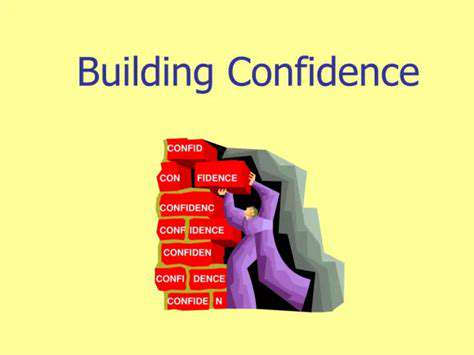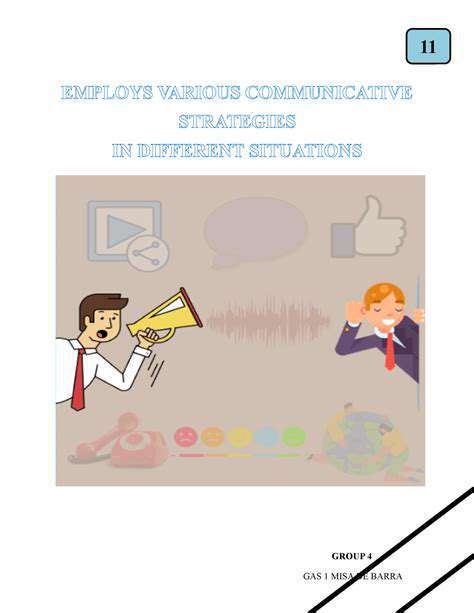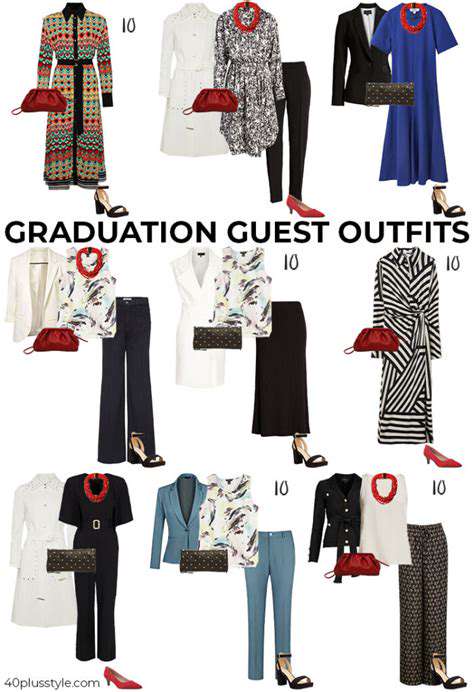How to Improve Your Eye Contact
Understanding the Importance of Eye Contact
Eye contact is a fundamental aspect of human communication, playing a crucial role in conveying confidence, engagement, and sincerity. It's more than just a visual cue; it's a powerful nonverbal signal that helps build rapport and fosters a connection with others. By consciously engaging in eye contact, you can significantly enhance your ability to communicate effectively and build stronger relationships.
Observing and understanding how others respond to your eye contact can provide valuable insights into their emotional state and how your message is being received. This awareness is key to adapting your communication style and improving overall interaction quality.
The Impact of Eye Contact on Confidence
Maintaining steady, appropriate eye contact can dramatically boost your perceived confidence level. It signals to others that you are present, engaged, and sure of yourself. Conversely, avoiding eye contact can often be interpreted as a lack of confidence, shyness, or even dishonesty. Practicing eye contact, even when feeling self-conscious, can help you project a more confident image and improve your overall communication style.
Overcoming the fear of making eye contact is a process that takes practice. But the benefits, in terms of perceived confidence and improved communication, are well worth the effort.
Eye Contact and Rapport Building
Establishing rapport with others is essential for effective communication and building strong relationships. Eye contact is a vital tool in this process. By making eye contact, you demonstrate genuine interest in the other person, creating a sense of connection and mutual respect. This, in turn, can lead to more open and meaningful conversations.
Consistent and appropriate eye contact helps create a feeling of trust and encourages the other person to reciprocate the engagement. This back-and-forth exchange is crucial in building rapport and fostering positive interactions.
Cultural Nuances in Eye Contact
Cultural norms significantly influence the interpretation of eye contact. What is considered appropriate eye contact in one culture might be viewed as rude or disrespectful in another. Understanding and respecting these cultural differences is essential for effective cross-cultural communication. Being mindful of these subtle nuances can prevent misunderstandings and foster more harmonious interactions across diverse groups.
Strategies for Improving Eye Contact
Improving your eye contact skills requires conscious effort and practice. Start by focusing on making brief, sustained eye contact during conversations. Practice in low-pressure situations, such as conversations with friends or family, to build confidence. Gradually increase the duration and frequency of your eye contact as you become more comfortable. Using mirrors to observe your own body language can also provide valuable feedback.
Practicing Eye Contact in Different Contexts
Eye contact is essential in various communication contexts. In professional settings, maintaining appropriate eye contact demonstrates professionalism, respect, and engagement. In social settings, it fosters connection and rapport. Even in presentations or public speaking, eye contact with different audience members can make your delivery more engaging and impactful.
By practicing in various scenarios, you can refine your eye contact skills and make them an integral part of your communication toolkit.
Building Confidence: Overcoming the Fear of Eye Contact

Building a Strong Foundation
Developing confidence isn't about overnight transformations; it's a journey of consistent self-improvement. Understanding your strengths and weaknesses is the first step. Reflect on past successes, no matter how small. Acknowledging these achievements builds a solid foundation for future confidence-boosting efforts.
Recognizing your limitations is equally important. Don't shy away from areas where you need improvement. Instead, approach them with a growth mindset, viewing challenges as opportunities for learning and development. This holistic self-assessment is crucial for building a realistic and sustainable sense of self-worth.
Identifying Limiting Beliefs
Often, low self-confidence stems from ingrained negative beliefs about oneself. These beliefs, often formed in childhood or through past experiences, can significantly impact how we perceive our abilities and worth. Identifying these limiting beliefs is the first step towards challenging and replacing them with more positive and empowering ones. These beliefs can be deeply ingrained and challenging to identify, but with conscious effort, they can be challenged and changed.
Setting Realistic Goals
Setting achievable goals is essential for building confidence. Large, overwhelming tasks can feel insurmountable, leading to feelings of inadequacy and frustration. Instead, break down larger goals into smaller, more manageable steps. This approach fosters a sense of accomplishment with each step, gradually building momentum and increasing confidence.
Practicing Self-Compassion
Treating yourself with kindness and understanding is crucial for cultivating self-confidence. Be your own best friend, offering encouragement and support, especially during challenging times. Forgive yourself for mistakes and setbacks; they are inevitable parts of the learning process. Remember that everyone makes errors, and embracing this reality is key to moving forward with resilience.
Building a Support System
Surrounding yourself with supportive individuals who believe in you can significantly impact your confidence. Seek out people who encourage your growth and offer constructive feedback. These individuals can provide a safe space for vulnerability and help you navigate challenges with renewed perspective and strength. A robust support network is vital in times of struggle.
Celebrating Small Victories
Acknowledge and celebrate your progress, no matter how small. Recognizing accomplishments, big or small, reinforces a positive self-image and builds momentum. This practice fosters a cycle of success and confidence, motivating you to continue striving for your goals. Regularly acknowledging and celebrating these milestones is essential to maintaining motivation and building a lasting sense of self-worth.
Practicing in Different Situations: From Interviews to Everyday Interactions

Realistic Scenarios for Enhanced Skill
Practicing in various situations is crucial for developing proficiency in any skill. This encompasses more than just replicating ideal conditions; it involves embracing the unexpected and learning to adapt. By practicing in diverse environments, individuals gain a deeper understanding of their strengths and weaknesses, enabling them to refine their approach and become more resilient. For example, a musician might practice in a quiet room, a busy coffee shop, and a large concert hall to understand how their performance might vary in different acoustic settings. This adaptability translates to better performance under pressure and a more robust skill set.
Simulating real-world situations, even if simplified, provides invaluable experience. For instance, a business professional can role-play negotiations or client interactions in a controlled setting to prepare for challenges they might encounter in actual situations. This allows for the development of crucial decision-making skills and confidence when facing difficult or unfamiliar circumstances. Through practical application and iterative adjustments, individuals can progressively improve their ability to handle these situations with greater effectiveness.
Adapting to Unforeseen Circumstances
Practicing in unfamiliar or challenging situations helps build resilience and adaptability. When faced with unexpected obstacles, individuals who have practiced in diverse environments are better equipped to adjust their strategies and maintain composure. This includes learning to overcome disruptions, manage distractions, and adapt to changing conditions. This adaptability is a vital skill in navigating the complexities of daily life.
For example, a student might practice taking exams in a noisy environment or with limited time to develop time management skills and stress tolerance. This will allow them to perform better when faced with similar situations during actual exams. Practicing in various scenarios equips individuals with the mental fortitude to handle the unexpected and emerge from challenges with strength and confidence.
Leveraging Feedback for Continuous Improvement
Seeking and incorporating feedback from others is essential for growth in any skill. Practicing in different situations provides opportunities to receive various perspectives, allowing individuals to understand their performance from multiple angles. This feedback loop, when effectively utilized, can be a powerful catalyst for improvement, helping refine techniques and identify blind spots. This crucial process of continuous feedback fosters self-awareness and drives progress.
Practitioners should actively solicit feedback from mentors, peers, or coaches. Constructive criticism, even when challenging, can help individuals identify areas for improvement and refine their approach. By consistently seeking feedback and actively incorporating it into their practice, individuals can accelerate their learning curve and achieve greater mastery. This iterative process of feedback and adaptation is key to long-term skill development.
Beyond the Basics: Enhancing Your Communication Style
Understanding the Power of Eye Contact
Effective communication isn't just about the words you speak; it's also deeply rooted in nonverbal cues, and eye contact is arguably the most powerful of these. Maintaining appropriate eye contact demonstrates engagement, sincerity, and respect for the person you're interacting with. It fosters a connection that goes beyond the spoken word, allowing for a more profound and meaningful exchange. This understanding of the impact of eye contact is crucial to enhancing your overall communication style.
Conversely, avoiding eye contact can convey a lack of confidence, dishonesty, or disinterest. By understanding the subtleties of eye contact, you can learn to use it effectively to build rapport, strengthen your message, and ultimately, improve your communication skills in various professional and personal settings.
Varying Eye Contact for Different Contexts
The duration and intensity of eye contact should be adjusted depending on the situation. During a formal presentation, sustained eye contact with individual audience members can create a sense of connection and engagement, while maintaining a broad sweep of the room can ensure everyone feels included. This ability to adapt your eye contact is key to maximizing its positive impact.
In a casual conversation, a more relaxed and intermittent eye contact is appropriate. This allows for a natural flow of conversation and shows genuine interest in the other person's perspective. Practicing flexible eye contact allows you to navigate various social situations with greater ease and confidence.
Mastering the Art of Sustained Engagement
Sustained eye contact, when used correctly, can be a powerful tool. It can convey confidence, seriousness, and a genuine interest in what the other person is saying. However, it's essential to understand that prolonged eye contact can sometimes be perceived as aggressive or intimidating, so finding the right balance is critical. Practicing this nuanced skill will allow you to leverage eye contact to your advantage in any setting.
Knowing when to break eye contact and when to maintain it is crucial. This skill comes with practice and understanding the context. Think about how the person you're speaking to reacts, and adjust your eye contact accordingly. This dynamic approach will help you connect with others on a deeper level.
Overcoming Shyness and Avoiding Awkwardness
For many, maintaining eye contact can be a challenge, particularly for those who are shy or introverted. However, developing this skill is achievable with practice and patience. Start by focusing on brief, direct glances, gradually increasing the duration and intensity as you become more comfortable. Visualizing yourself confidently making eye contact can also help build your self-assurance.
Practicing in low-pressure environments, such as with friends or family, can help you build confidence and overcome any anxieties. Remember, eye contact is a crucial component of communication, and improving your skill in this area can positively impact your interactions with others.
The Role of Culture and Personal Space
Cultural norms play a significant role in how eye contact is perceived. In some cultures, prolonged eye contact is considered respectful and a sign of engagement, while in others, it may be interpreted as rude or aggressive. Understanding these cultural nuances can help you avoid misinterpretations and ensure positive interactions in diverse settings. Being sensitive to cultural differences is crucial for effective communication.
Additionally, personal space plays a role. The amount of eye contact that is appropriate depends on how close the person is to you. Respecting personal space and adjusting your eye contact accordingly will enhance your interactions and prevent discomfort or miscommunication, making you appear more approachable and understanding.
Read more about How to Improve Your Eye Contact
Hot Recommendations
- Grooming Tips for Your Bag and Wallet
- Best Base Coats for Nail Longevity
- How to Treat Perioral Dermatitis Naturally
- How to Use Hair Rollers for Volume
- How to Do a Graphic Eyeliner Look
- Best DIY Face Masks for Oily Skin
- Guide to Styling 4C Hair
- Guide to Improving Your Active Listening Skills
- How to Fix Cakey Foundation
- Best Eye Creams for Wrinkles

![How to Do a Red Lip Look [Classic & Bold]](/static/images/29/2025-05/MasteringtheClassicRedLip3AATimelessChoice.jpg)





![Grooming Tips for Women [Daily Habits]](/static/images/29/2025-05/NailCareforPolishedPerfection.jpg)



